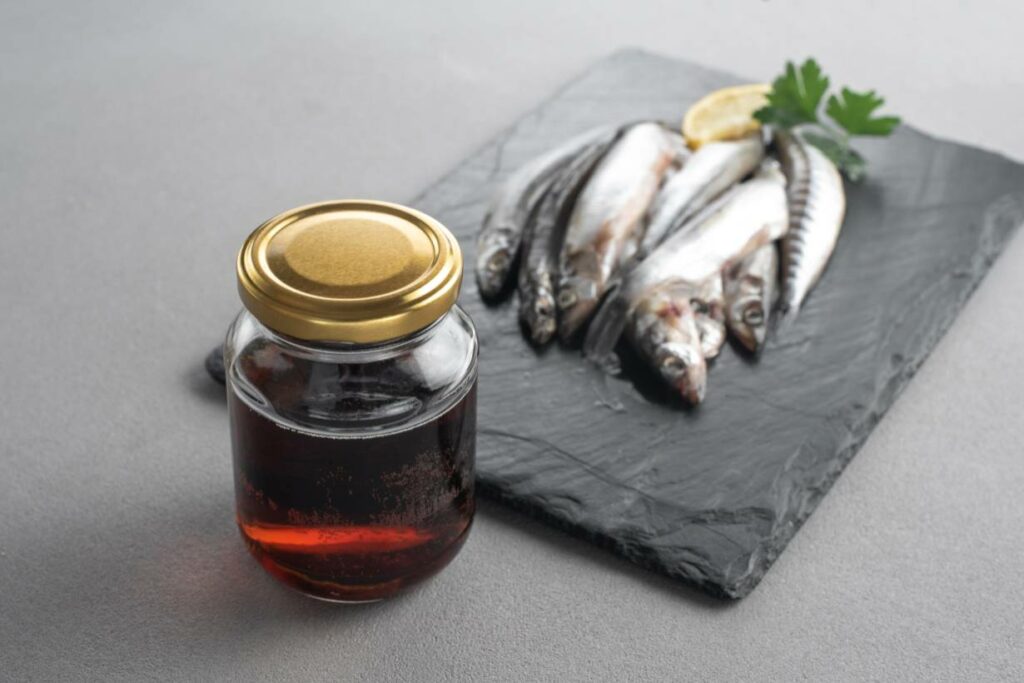Disclosure: This post may contain affiliate links. This means that if you click on one of these links and then buy something, we will get a small commission. It won’t cost you anything extra. All opinions are our own.
While the sauce is highly valued for its flavor-enhancing properties, what nutritional benefits does it offer?
This article provides a comprehensive guide to the nutritional values of fish sauce, its benefits, and potential downsides.
Fish sauce is a popular condiment used in Southeast Asian and East Asian cuisine that provides a rich, umami flavor. It’s made by fermenting small fish like anchovies with salt. Some people wonder if the omega-3 fatty acids present in fish carry over to the final fish sauce product. This article examines whether fish sauce contains omega-3s and provides an overview of its overall nutritional value.
What are Omega-3 Fatty Acids?
Before looking at fish sauce specifically let’s review what omega-3 fatty acids are and why they matter for health.
Omega-3s are a type of polyunsaturated fat found naturally in some foods, The main omega-3s of interest are
- EPA (eicosapentaenoic acid)
- DHA (docosahexaenoic acid)
- ALA (alpha-linolenic acid)
EPA and DHA are primarily found in seafood, while ALA is present in plant sources like walnuts, flaxseed, and chia seeds.
These essential fats provide wide-ranging benefits for the cardiovascular system, brain health, inflammation reduction, fetal development, and more. That’s why nutrition experts recommend getting adequate omega-3s from our diet
Nutritional Profile of Fish Sauce
Fish are a prime source of omega-3s. But does their nutrient composition carry over after going through the fish sauce production process?
Here is an overview of the basic nutritional profile of fish sauce based on USDA data:
-
Fat – Fish sauce contains minimal amounts of fat at less than 0.5 grams per tablespoon serving.
-
Omega-3s – It provides tiny traces of omega-3s, but less than 1 mg per serving, so not a significant source.
-
Protein – Fish sauce supplies under 1 gram of protein per tablespoon.
-
Sodium – It is high in sodium at around 1500 mg per tablespoon, 75% of the daily upper limit.
-
Vitamin B12 – Contains a small amount of B12 at 3.8% DV.
-
Magnesium – Provides 7.5% DV of magnesium.
Why Fish Sauce is Low in Omega-3s
Fish are abundant in EPA and DHA omega-3 fatty acids. But these delicate polyunsaturated fats are largely lost and broken down throughout the fish sauce production process:
-
Heating – To extract the fish essence, anchovies are cooked at temperatures that degrade omega-3s.
-
Salt – The high salt used accelerates omega-3 oxidation.
-
Fermenting – The months-long fermentation period also causes oxidation.
-
Pressing – Mechanical pressing of the fish solids removes remaining omega-3s.
So due to this combination of heating, salting, fermenting, and pressing, fish sauce retains only negligible traces of omega-3 content from its fish ingredients.
Benefits of Omega-3s Lost in Processing
Since fish sauce contains minimal omega-3s, it won’t provide the same health benefits linked to omega-3 consumption:
-
Heart health – Omega-3s support cardiovascular function and reduce heart disease risk, which fish sauce will not provide.
-
Brain function – The long-chain EPA and DHA in fish are crucial for optimal brain health and development, but these are not present in meaningful amounts in the sauce.
-
Anti-inflammatory effects – Omega-3s have anti-inflammatory properties that can alleviate chronic inflammation. Fish sauce does not supply these anti-inflammatory omega-3s.
-
Eye and vision health – DHA benefits eye health, but fish sauce is not a source of this important omega-3 fat.
Health Benefits Fish Sauce Does Provide
Though fish sauce is low in omega-3s, it can still offer some potential benefits:
-
Adds flavor – The rich, umami taste of fish sauce improves the palatability of dishes, encouraging consumption of nutritious whole foods.
-
Contains antioxidants – Fish sauce supplies polyphenols and peptides with antioxidant properties that may help counter oxidative stress.
-
Low calorie – With only about 6 calories per serving, fish sauce can provide flavor without adding significant calories.
-
Probiotic potential – Some beneficial microbes may survive the fermentation process, offering probiotic effects. But levels can be low and viability questionable.
So while not a nutritional powerhouse, fish sauce can provide flavor and antioxidant compounds, in addition to being low-calorie.
Downsides of Relying on Fish Sauce for Omega-3s
Below are some of the drawbacks of trying to use fish sauce as a meaningful source of omega-3 fatty acids:
-
Nearly devoid of omega-3s – Fish sauce simply does not contain more than trace levels, so it cannot meaningfully contribute to omega-3 intake.
-
High in sodium – With about 1500mg of sodium per tablespoon, fish sauce is very high in salt, which should be limited.
-
Use is not essential – While popular in some cuisines, fish sauce itself is not an essential ingredient, so is easy to exclude to avoid excess sodium.
-
Allergies – Fish and shellfish allergies preclude the use of fish sauce as an omega-3 source.
Overall, fish sauce is a poor choice for providing beneficial omega-3s due to processing removing them almost entirely.
Better Dietary Sources of Omega-3 Fatty Acids
Instead of relying on fish sauce for omega-3s, focus on eating the following foods rich in EPA, DHA, and ALA:
EPA/DHA Sources:
-
Fatty fish like salmon, mackerel, sardines
-
Shellfish including oysters, mussels, shrimp
-
Fish oil supplements (also cod liver oil)
-
Grass-fed beef and lamb (moderate amounts)
ALA Sources:
-
Walnuts, flaxseed, chia seeds
-
Canola oil, soybean oil
-
Brussels sprouts, kale
-
Edamame, kidney beans
Aim for at least two servings per week of fatty fish or take a fish oil supplement to get 500mg combined EPA/DHA daily, according to recommendations. Include plant sources of ALA as well.
Omega-3 Enhanced Fish Sauce Alternatives
Some companies now produce enhanced fish sauces fortified with omega-3s. These provide EPA/DHA levels comparable to typical fish oil supplements.
If interested in a fish sauce with omega-3s added, look for varieties fortified with at least 300-500mg combined EPA/DHA per serving.
But be mindful that these omega-3 enhanced fish sauces will still be high in sodium, so moderate intake.
The Bottom Line
In conclusion, despite being made from fish, the fermentation and pressing process to make fish sauce removes nearly all the heart-healthy omega-3 fatty acids present in the whole fish. Fish sauce only provides trace levels, rather than being a meaningful source.
For sufficient omega-3s, it’s best to get them from foods like fatty fish, fish oil supplements, walnuts, and flaxseeds, or use an omega-3 fortified sauce alternative.
While fish sauce can provide flavor and antioxidant compounds, relying on it for omega-3 intake will leave you deficient. Focus on other dietary sources to enjoy the wide-ranging benefits of omega-3 fatty acids.

What Is Fish Sauce?

Fish sauce has been part of the human diet for thousands of years. For example, the Romans had their own widely used version of the sauce called “garum” (1).
In more recent times, fish sauce is not so popular culturally in the Western world today. However, it is a staple part of the diet in many Asian countries, including China, Japan, Korea, Thailand, and Vietnam, among others (2).
Fish sauce provides a deep “umami” and salty flavor to food. As such, it is a valued ingredient for giving numerous dishes a greater complexity in taste.
Contrary to what one might expect, fish sauce does not have a strong “fishy” taste. It does have a slight seafood-like taste, but it shares some flavor similarities with condiments like soy sauce.
Generally speaking, fish sauce is used in cooked dishes. That said, it is a versatile ingredient, and people commonly use it to help flavor fermented foods. A common example of this is kimchi, the national dish of Korea (3, 4).
Other uses of fish sauce include its use in marinades and dips.
Enhances the flavor of various dishes
Fish sauce provides a deep and complex flavor, significantly improving the overall taste of dishes.
Its strong flavor means that only a small amount is necessary; a single 18-gram tablespoon serving is enough.
Adding fish sauce to healthy home-cooked meals can make them taste better because it adds a unique umami and salty flavor.
Even though it’s not a benefit of fish sauce itself, making healthier meals more enjoyable can help people stick to better eating habits.
Omega 3 Fatty Acids in Canned Sardines (Part – 2) – Dr. Berg
Does fish sauce have omega-3?
While the exact omega-3 content of fish sauce may vary, it generally contains a notable amount of EPA and DHA. Studies have demonstrated that the omega-3 in fish sauce has a good bioavailability, which means that our bodies can easily absorb and use it. Incorporating fish sauce into your meals can help increase your omega-3 intake.
How much omega 3 is present in salmon compared to other fish?
Salmon contains 2150 milligrams of omega-3 per serving, which is a good amount. Mackerel for example contains much more, 4580 milligrams per serving, herring 2150 milligrams, oysters 329 milligrams, sardines 1463 milligrams, anchovies 411 milligrams and caviar 1046 milligrams.
Does fish sauce have mineral content?
Table 3: Mineral composition of fish sauce per 18-gram tablespoon serving Fish sauce contains high levels of sodium and provides a moderate source of magnesium. Besides this, it has a relatively low mineral content. Here is an overview of fish sauce’s benefits, whether nutritional in nature or down to its distinct characteristics.
Is fish a good source of omega-3 fatty acids?
Fish is the best natural source of omega-3 fatty acids, but some people are concerned about other, potentially harmful ingredients that may be in fish such as mercury, PCBs (polychlorinated biphenyls) and environmental contaminants.
